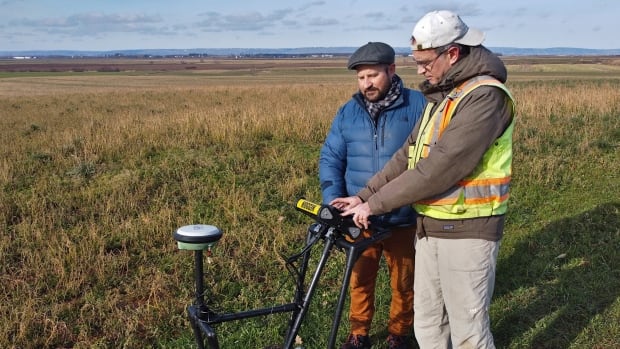
An archeological team from Saint Mary’s University will travel to France this summer to use ground-penetrating radar and other technology to assist a United States defence agency recover and identify military personnel missing since the Second World War.
The team from the anthropology department at the Halifax university has agreed to work with the Defense POW/MIA Accounting Agency, which is responsible for identifying the remains of missing soldiers, sailors and aircrew from past conflicts.
Anthropology professor Jonathan Fowler, one of Canada’s leading researchers in archeological geophysics and remote sensing, said he received an email “out of the blue” from the director of the U.S. agency in 2017.
The email, he said, “told us that their mandate is so vast that they are always looking for partners to help do this work,” Fowler said in an interview. “Word had gotten out on what we were doing so we came up on their radar and they reached out.”
The professor works with ground-penetrating radar, which uses radio waves to locate the depth of buried objects. He also uses magnetic surveys and aerial mapping.
Fowler’s previous research was used to map burials associated with the 1873 sinking of the SS Atlantic near Lower Prospect, N.S., and to identify nearly 300 unmarked graves in the pre-deportation Acadian cemetery at Grand-Pre National Historic Site. He was also called to help the Sipekne’katik First Nation in Nova Scotia locate potential graves at the former Shubenacadie Indian Residential School site.
Radar and magnetic surveys
“We worked with Saint Mary’s to create a proper memorandum of understanding with our American colleagues, and now we are embarking on this new collaboration,” Fowler said.
Fowler said the university’s technology was intriguing to the U.S. agency, which doesn’t normally use radar or magnetic surveys at most of its dig sites.
“They initially came to us looking for traditional boots on the ground, field technician-type assistance,” he said. “In our conversations with them we pointed out that there are all sorts of things you might gain from trying these (relatively) new technologies.”
Saint Mary’s adjunct professor Aaron Taylor is to direct the first field project, scheduled for July, which will focus on a Second World War bomber crash site in northwestern France. Taylor said he will be taking with him a crew of 16, including eight of the most qualified students from across Canada.
It’s likely the team will find some remains, he said, because of the meticulous research the U.S. agency has already done in France.
“This site has been investigated and based on the records and the mission report it’s been viewed that there is someone in the debris,” Taylor said. “We are assigned to try to find enough bone material to make an identification.”
1,855 Canadian aircrew missing in action
The professor said any material found at the site will be sent to a lab in Hawaii, which will conduct the painstaking process of identification.
Taylor, who has a passion for military history, said it frustrates him that Canada doesn’t have a similar program to find its missing in action. Instead, he said, Canada employs a forensic anthropologist — working with a small budget — to identify remains of missing military personnel who are unintentionally unearthed, usually by farmers and construction developers and mostly in European battlefields.
Taylor said there are 1,855 Canadian aircrew members listed as missing in action.
“We know where a lot of these crashes are, they’re in after-action mission reports,” he said. “So my ultimate goal is to have a program for Canada. We have a sacred duty to when possible bring our missing home and provide closure to their families.”
According to its website, the Defense POW/MIA Accounting Agency searches for missing personnel from the Second World War, the Korean War, the Vietnam War, the Gulf Wars and other recent conflicts. The agency says more than 81,500 American service personnel remain missing.